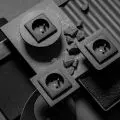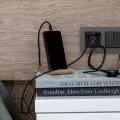What you need to know about a flat roof....
Aflat roof is a structure that brings with it many tangible advantages. This system not only allows you to maximize the amount of usable space available in the building, but also provides the possibility to develop the area of the roof itself. However, due to its flat construction, it is extremely important to make it in a way that provides it with high mechanical strength, while maintaining adequate vapor barrier and effective drainage of moisture.
Flat roof
© SUEZ Izolacje Budowlane
What layers to consider when designing a flat roof?
Proper flat roof design requires the use of what is known as a multi-layer system. It consists of five separate layers that complement each other, thereby guaranteeing full airtightness, eliminating the risk of thermal bridges, and providing the load-bearing capacity required by the design.
Designing a flat roof requires consideration of the following elements, which include:
- load-bearingstructure - its task is to ensure proper load-bearing capacity and mechanical strength;
- vapor barrierlayer - it is an airtight barrier to prevent the passage of watervapor from the interior of the building and the surrounding attics to the subsequent layers of the flat roof;
- thermal insulation layer - its task is to reduce the amount of heat penetrating the roof surface; this makes it possible to significantly increase the thermal comfort of those using the building, while reducing the costs associated with its heating or cooling;
- slope layer - it is responsible for maintaining the proper angle of inclination, which allows for the full self-removal of water accumulating on the roof surface by gravity;
- waterproofing layer - it is to protect against the penetration of moisture and driving rain into the rest of the roof's structural elements;
Flat roof with attic wall - point drain in the central part
© SUEZ Izolacje Budowlane
It is also imperative that the design of a flat roof includes additional accessories in the form of roof drains and drainage systems. They will ensure efficient disposal of rainwater from the roof surface, while protecting the facade and foundations from damage caused by moisture.
Cross-section in front of a flat green roof with TOPWET roof drain
© SUEZ Izolacje Budowlane
What materials should be provided for the various layers of a flat roof?
Selecting the right materials is a key aspect for designing a multi-layer flat roof that will be durable and, above all, airtight.
Supporting structure of the flat roof
The load-bearing structure of a flat roof usually uses materials such as:
- four-sided planed chamber-dried wood or I-beams;
- steel and fully galvanized profiled beams for ceilings along with high-grade trapezoidal sheets;
- floor slabs made of reinforced concrete bearing slab;
It is extremely important, however, that the material used for the load-bearing structure be selected both in terms of the planned design load on the flat roof and the thermal insulation layer itself. Therefore, in order to create a usable surface, it will be necessary to use materials with adequate strength - in particular, reinforced concrete slabs.
Vapor barrier layer of a built-up roof
Another key structural element of a flat multilayer roof is the vapor barrier. The purpose of the vapor barrier is to prevent the water vapor that collects inside the building from penetrating the successive layers that make up the flat roof.
In the past, PE (polyethylene) film was often used to make a vapor barrier. However, this method was not able to ensure proper airtightness, due to the difficulty of joining individual strips of PE film together and permanently attaching them to the main covering layer of the flat roof. To make matters worse, polyethylene materials are also extremely susceptible to damage during installation work, increasing the risk of leaks.
Therefore, a much better material for the vapor barrier layer are special bitumen membranes equipped with an integrated aluminum insert. This plastic guarantees the maintenance of an SD coefficient in excess of 1500 regardless of the thickness of the membrane. Bitumen membranes are also highly resistant to mechanical damage, thus allowing the surface to move freely.
Another indisputable advantage of this material is the possibility of staging the work, allowing to interrupt installation activities in case of an emergency.
However, it is important that the design of the flat roof includes the use of special system drains responsible for the efficient removal of excess precipitation. TOPWET roof drains can perform this task.
Thermal insulation layer of a flat roof
The role of the thermal insulation layer is to reduce heat transfer through the flat roof. This helps increase the thermal comfort of the occupants of a building, as well as minimize the bills needed to heat the building.
The thermal insulation layer must meet all the stringent requirements set forth in the Technical Specifications (TC), which is why a good grade of polystyrene (EPS) or styrodur (XPS) is usually reached for its construction. However, it is extremely important that these materials have increased mechanical strength and resistance to compressive stress.
The insulator should also have high fire resistance corresponding to at least RE 15 certification. Therefore, for buildings particularly prone to fire ignition, it is worth choosing PIR foam or rock wool or mineral wool.
Roof pitches
© SUEZ Izolacje Budowlane
The pitch layer of a flat roof
Thedesign of a flat roof must also provide for a slope layer. This is crucial, because otherwise rainwater will not be properly drained from the roof surface.
The best material for this stage of work will be polystyrene with higher mechanical strength, namely EPS 100. It can be successfully used on any roof support structure.
However, when designing a flat roof, you should avoid making a sloping layer in the form of concrete screeds made on stepped polystyrene. This method is outdated, and its use can lead to rapid and costly degradation of the thermal insulation layer.
Flat roof with EPDM membrane
© SUEZ Izolacje Budowlane
Waterproofing layer
The last layer of a flat roof is the waterproofing layer. The materials used for it should be selected according to how the roof surface will be used.
For utility structures and the anticipated installation of photovoltaic panels, bituminous membranes should be chosen. They are highly resistant to mechanical damage, allowing the entire roof surface to move freely. On the other hand, in the case of non-utility roofs with a large surface area, bituminous membrane can be replaced with a PVC or EPDM membrane without concern.
Selection of roof accessories
Drainage elements
Proper design of a flat roof must provide for the use of drainage elements that will protect it from excessive rainwater or melting snow. These can be gravity or vacuum systems. Due to the lower cost and simplicity of construction, investors usually go for the first variant.
Detail of installation of a straight roof drain with superstructure
© SUEZ Izolacje Budowlane
Roof drains
The most important part of any drainage system are roof drains, which allow efficient removal of water from the surface of a flat roof. Many specialists particularly recommend vertical or horizontal roof drains of the LORO or TOPWET brand, which are equipped with an integrated flange made of material matching the insulation layer used on the roof. Their design, unlike that of cheaper competitors, guarantees the continuity of insulation over the entire surface of the flat roof.
TOPWET vertical roof drain with outlet
© SUEZ Izolacje Budowlane
Gravel baskets
On the other hand, in the case of structures landscaped with greenery, the design of a flat roof must include the use of special gravel baskets. Their design protects drainage pipes from clogging with soil, while allowing excess water to drain efficiently.
Green flat roof
© SUEZ Izolacje Budowlane
Drainage chasers
When designing a flat roof, it should also include a safety system in the form of dewatering chokers, which will act as an overflow valve. If the capacity of the drainage system is exceeded, TOPWET roof pukes will drain excess rainwater, protecting the flat roof structure from overloading.
Attic flat roof with roof gully with emergency overflow as roof protection against driving rain
© SUEZ Building Insulation
Flat roof design - summary
In summary, a flat roof brings many advantages, but it is important to remember to design it properly so that it will serve us for many years.
A flat roof consists of several layers, which must be properly connected, and each of them should be well chosen and made of recommended material. It is also important to remember the selection of roof accessories, which are essential, but often bring problems in the proper design of the detail of their installation.
Want to design a flat roof and avoid mistakes? At SUEZ Building Insulation, we specialize in doing just that! Contact our experts and get the knowledge you need for design and ready-made solutions to speed up your work.
For more information, visit the company's SUEZ Izolacje Budowlane Sp. z o.o. page on the A&B portal
and in the SUEZ Building Academy video series (details on flat roofs, waterproofing, terraces and balconies):
"Flat roof - how to make it right? Knowledge in a nutshell - SUEZ Building Academy".









































